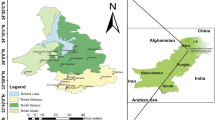Abstract
This study utilized the DRASTIC approach combined with GIS technology to assess groundwater vulnerability and contamination risks in a research area. The DRASTIC simulation generated a risk assessment map, categorizing locations based on vulnerability levels. The analysis revealed varying vulnerability levels, with areas of significant industrial activity and high population density exhibiting elevated nitrate levels in nearby wells. The model’s outcomes were validated against field measurements of nitrate concentrations, demonstrating a high degree of consistency. The R-index technique was employed to assess sensitivity to nitrate contamination, identifying areas at greater risk. The study highlights the importance of considering hydrogeological characteristics and agricultural practices for groundwater protection and management. Overall, the DRASTIC approach proves valuable in assessing groundwater risks and informs decision-making for sustainable resource management.











Similar content being viewed by others
REFERENCES
M. A. Akhtar, N. Akhtar, and M. Shoeb, J. Geol. Soc. Ind. 98 (7), 955–960 (2022).
A. Al-Rawabdeh, N. Al-Ansari, A. Al-Taani, F. Al-Khateeb, and S. Knutsson, Open Eng. 4 (3), 264–280 (2014).
S. Anbazhagan, Bull. Ind. Geol. Assoc. 26 (2), 117–123 (1993).
S. Anbazhagan, Bhu-Jal News 8 (2), 8–12 (1994).
S. Javadi, N. Kavehkar, M. Mousavizadeh, and K. Mohammadi, J. Agric. Sci. Technol. 13 (2), 239–249 (2011).
P. Bi, L. Pei, G. Huang, D. Han, and J. Song, Int. J. Environ. Res. Public Health 18 (22), 12143 (2021).
A. Leone, M. Ripa, V. Uricchio, J. Deak, and Z. Vargay, J. Environ. Manag. 90 (10), 2969–2978 (2009).
R. Khan and D. Jhariya, J. Geol. Soc. Ind. 92, 59–66 (2018).
S. Khan, Q. Cao, Y. Zheng, Y. Huang, and Y. Zhu, Environ. Pollut. 152 (3), 686–692 (2008).
G. Bartzas, F. Tinivella, L. Medini, D. Zaharaki, and K. Komnitsas, Inf. Process. Agric. 2 (2), 109–129 (2015).
H. Wang, Q. Yang, H. Ma, and J. Liang, Environ. Res. 200, 111449 (2021).
A. Hussain, Z. Salam Obaid, A. A. Kadhim Ruhaima, K. Al-Majdi, A. Faiz Hameed, P. Sivaraman, and A. S. Abed, Caspian J. Environ. Sci. 20 (5), 947–954 (2022).
D. Machiwal, M. K. Jha, V. P. Singh, and C. Mohan, Earth-Sci. Rev. 185, 901–927 (2018).
H. Rajput, R. Goyal, and U. Brighu, Environ. Earth Sci. 79, 1–15 (2020).
L. Aller and J. Thornhill, DRASTIC: A Standardized System for Evaluating Ground Water Pollution Potential Using Hydrogeologic Settings (Robert S. Kerr Environ. Res. Lab., Office of Research and Development, U.S. Environ. Protect. Agency, 1987).
O. Omotola, M. Oladapo, and O. Akintorinwa, Model. Earth Syst. Environ. 6, 1253–1280 (2020).
D. Jhariya, J. Geol. Soc. Ind. 93, 567–573 (2019).
B. Chakraborty, S. Roy, A. Bera, P. P. Adhikary, B. Bera, D. Sengupta, G. S. Bhunia, and P. K. Shit, Environ. Earth Sci. 81, 1–15 (2022).
T. Saranya and S. Saravanan, Int. J. Environ. Sci. Technol. 20 (2), 1837–1856 (2023).
L. Pattusamy, M. Rajendran, S. Shanmugamoorthy, and K. Ravikumar, Matéria (Rio de Janeiro) 28 (1) (2023).
Z. M. Babika, L. D. Bryant, T. R. Kieldsen, and A. I. Tukur, J. Geosci. Environ. Protect. 10 (4), 202–226 (2022).
ACKNOWLEDGMENTS
The authors are expressing their gratitude to Mahendra Engineering College and KSR College of Engineering for providing infrastructural facilities to complete this research successfully.
Funding
This work was supported by ongoing institutional funding. No additional grants to carry out or direct this particular research were obtained.
Author information
Authors and Affiliations
Corresponding author
Ethics declarations
The authors of this work declare that they have no conflicts of interest.
Additional information
Publisher’s Note.
Pleiades Publishing remains neutral with regard to jurisdictional claims in published maps and institutional affiliations.
Rights and permissions
About this article
Cite this article
Mohan, S., Muralimohan, N. & Vidhya, K. Contamination of Groundwater Assessment in Hard Rock Aquifer by Using Geographic Information System (Drastic Model) in the Thirumanimuthar Sub-basin, South India. Dokl. Earth Sc. 514, 149–160 (2024). https://doi.org/10.1134/S1028334X23601700
Received:
Revised:
Accepted:
Published:
Issue Date:
DOI: https://doi.org/10.1134/S1028334X23601700




